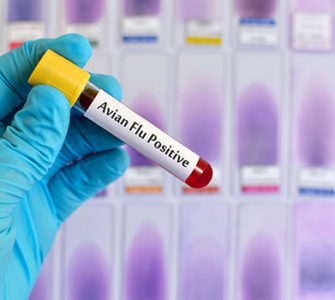Check farm biosecurity now ahead of potential avian flu return, disease expert says
Poultry producers should assess their farm biosecurity in preparation for a return of avian influenza this winter, according to an expert in the spread and control on animal disease.
Professor Ian Brown, head of virology at the UK’s Animal and Plant Health Agency (APHA), said there is a likelihood of the virus reappearing in poultry flocks around the world over the coming months.
And he said producers in the US, as well as Africa, Europe and South America, need to look at their preparedness against what is a very real threat to their businesses.
Speaking at the 2017 World Veterinary Poultry Association conference, Brown said if the same strain as the 2016 outbreak returns to the US or Europe this year, the virus will have a relatively low impact because the number of wild birds bringing it to either continent will be lower.
However, if the virus mutates into a new strain — which is possible — then the risk of the disease spreading is higher.
“Last year we had a large population of infected wild birds, so the ones that survived will probably be immune, so their susceptibility goes down,” said Brown, who is also director of the international reference laboratory for avian influenza at APHA-Weybridge.
“However, if it’s a new strain like H5N8 this winter, the wild birds might not be immune, and spread might happen.
“On probability, it would be surprising if no cases were found in Europe, but there is high uncertainty,” he added. “The probability of spread to the US is a step lower, but that’s not to say it couldn’t happen.”
Given the level of uncertainty and potential risk, Brown said the industry must work together to identify areas where biosecurity could be improved.
“Even if the virus is changing, the way it behaves and spreads remains the same, so the pathways in which it gets into a unit are not any different.
“This time of year, producers need to review their biosecurity and work as a group in the industry to set protocols: Producers need to be fastidious, as one case can cause the whole sector to suffer.”
Brown said practices such as compartmentalization — where multiple farms adopt common biosecurity measures to standardize their approach to protecting bird health — can be beneficial.
However, relatively simple measures — such as ensuring buildings are in a good state, and storing feed, bedding and equipment away from areas that wild birds can access — are just as important.
“The challenge for the industry is to look at the risks we know,” he said. “The riskiest period is September to April, so we need to think about how we can sustain that biosecurity.
“A lot is around educating staff: Either farmers don’t think it’s worth an investment, or staff don’t understand what the risks are.”
As well as education, producers also need to think about what measures are feasible for their own units, he added.
“Biosecurity comes at a cost, and some people might not be able to afford it,” he said. “It has to come down to collective industry standards.
“At the other end, governments could find ways to encourage producers to maintain and comply with industry standards, which in some countries is being linked to compensation.
“It’s the profitability of their business and the industry at stake, so measures have to be tough.”
Posted on December 7, 2017

















